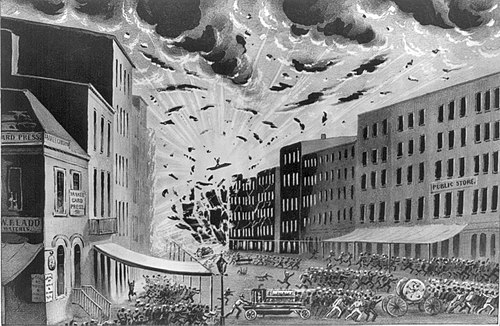
The fire that broke out in Manhattan on July 19, 1845, was one of the most devastating disasters in the history of New York City, leaving a profound impact on the city's collective memory and resulting in significant human and financial losses. This catastrophe left a lasting mark on Manhattan's urban landscape and prompted significant improvements in firefighting practices and building safety.
The Beginning of the Fire
The fire originated in a factory located in the southern district of Manhattan, an area densely populated with wooden buildings, including warehouses, factories, and shops. The exact cause of the fire remains unclear, but it is generally believed to have been an accident related to the use of a heat source or negligence in handling flammable materials.
On the day of the fire, weather conditions exacerbated the rapid spread of flames. Strong winds blew through the region, fanning the flames and causing secondary fires that quickly spread to neighboring buildings.
Extent of the Damage
Due to the density of constructions and the lack of rigorous fire safety standards at the time, the fire spread rapidly through Manhattan's narrow streets. Within just a few hours, as many as 345 buildings were reduced to ashes. Among the structures destroyed were public buildings, churches, businesses, and homes.
The human toll was also heavy, with at least 30 people losing their lives in this disaster. Rescue efforts were complicated by difficulties in accessing the affected areas, congested streets, and a lack of modern firefighting equipment.
Consequences and Reforms
The 1845 Manhattan fire was a wake-up call for local authorities, leading to significant reforms in fire prevention and firefighting. The financial repercussions of the disaster were also considerable, with damages estimated at least $5 million at the time, equivalent to several hundred million dollars today.
As a result of this tragic event, fire prevention measures were strengthened. Better-equipped and trained fire services were established, and stricter building standards were adopted to limit the use of wood and promote more fire-resistant materials.
The fire also sparked a public debate on the need to create a more efficient water supply system for firefighters, ultimately leading to the establishment of a water pipeline network to facilitate firefighting in the city.
Legacy and Memory
The memory of the July 19, 1845, Manhattan fire has been preserved through generations, serving as a reminder of the importance of fire safety in densely populated urban areas. Today, the event is studied in history and architecture schools to highlight the evolution of construction and fire prevention practices over time.
Though tragic, this catastrophe played a crucial role in implementing preventative and more stringent safety measures, contributing to making cities more resilient against fire hazards.
In conclusion, the July 19, 1845, Manhattan fire remains a significant event in the history of New York, illustrating the need for thoughtful urban planning and appropriate safety measures to prevent and manage fire disasters.
Soerfm, Public domain, https://en.wikipedia.org/wiki/Great_New_York_City_Fire_of_1845#/media/File:NYC_Fire_1845_explosion_loc.jpg


0 comments: